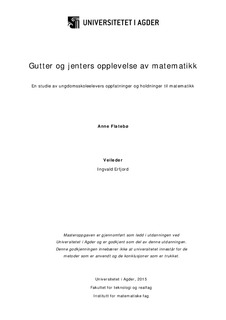| dc.contributor.author | Flatebø, Anne | |
| dc.date.accessioned | 2015-09-21T07:58:52Z | |
| dc.date.available | 2015-09-21T07:58:52Z | |
| dc.date.issued | 2015 | |
| dc.identifier.uri | http://hdl.handle.net/11250/300806 | |
| dc.description | Masteroppgave matematikkdidaktikk- Universitetet i Agder, 2015 | nb_NO |
| dc.description.abstract | There are many studies focusing on mathematics in school with particular attention to boys’
and girls’ perspective. I want to give a new contribution that considers whether there are
differences in how boys and girls see themselves in relation to mathematics. I also want to
investigate whether a decreasing level in grades in mathematics tests have an effect on how
students see themselves in relation to the subject. This is discussed by looking at students'
beliefs and attitudes towards the learning and teaching of mathematics. I also want to look at
the type of teaching and tasks boys and girls prefer. Data collection is done by conducting a
survey on 8th grade and on 10th grade to investigate possible changes or stability during these
three years. The aim of this study is to see if there actually are differences in which beliefs
and attitudes boys and girls have to mathematics and the teaching of the subject. Furthermore,
if there are differences in how boys and girls prefer to work with the subject. I analyse
students’ written responses to questions and statements in questionnaires and in oral
comments in interviews with particular attention to differences in responses from girls and
boys and how this may change during lower secondary school.
The study presents two research questions:
Which beliefs and attitudes towards mathematics have boys and girls on 8th and 10th
grade?
Do boys and girls like and succeed with the same working methods and tasks in
mathematics education?
To investigate these research questions, I used a qualitative approach. First, there was a
written survey among students on 8th and 10th grade, where 26 pupils from each grade
participated. This was followed by interviews of three students in 10th grade who had
experienced a drop in their grade level in mathematics. The material consists therefore of both
the survey and interviews.
Analytical findings from the study indicate that there are no big differences when it comes to
beliefs and attitudes of boys and girls. It may appear that there are some minor differences
between boys and girls in terms of what they think about mathematics. The boys are in a
slight majority to think that the subject is boring, while many of the girls angles it a
challenging subject. It may also indicate that there has been some change from 8th to 10th
grade for the boys. In 10th grade also mostly of the boys expresses that the subject could be
challenging.
Another finding from the study is a difference between girls and boys in their desires when it
comes to working with the subject and mathematic tasks. More boys than girls on 8th grade
wanted to work with others, while several of the girls prefer to work alone. Regarding
preferences for types of mathematics tasks, differences between boys and girls were found.
Many of the boys expressed on 8th grade that they liked best to work with ICT while the girls
enjoyed working with larger tasks. For the boys, this appear to have changed through lower
secondary school. In 10th grade, there were several who liked better working with similar
tasks than ICT.
The study contributes with findings indicating that the instructions appear to be closer to
what the girls than the boys preferred. This may work as a reason why girls express a more
vii
positive belief about mathematics and have a development in grades compared to boys during
lower secondary school. | nb_NO |
| dc.language.iso | nob | nb_NO |
| dc.publisher | Universitetet i Agder ; University of Agder | nb_NO |
| dc.subject.classification | MA 502 | |
| dc.title | Gutter og jenters opplevelse av matematikk En studie av ungdomsskoleelevers oppfatninger og holdninger til matematikk | nb_NO |
| dc.type | Master thesis | nb_NO |
| dc.subject.nsi | VDP::Mathematics and natural science: 400::Mathematics: 410 | nb_NO |
| dc.subject.nsi | VDP::Social science: 200::Education: 280 | nb_NO |
| dc.source.pagenumber | 85 s. | nb_NO |
